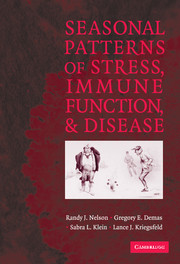Book contents
- Frontmatter
- Contents
- Acknowledgments
- Foreword
- Preface
- 1 Seasonality
- 2 Immune Function
- 3 Seasonal Fluctuations in Disease Prevalence
- 4 Seasonal Changes in Immune Function
- 5 Photoperiod, Melatonin, and Immunity
- 6 Energetics and Immune Function
- 7 Hormonal Influence on Immune Function
- 8 Clinical Significance of Seasonal Patterns of Immune Function and Disease
- References
- Index
8 - Clinical Significance of Seasonal Patterns of Immune Function and Disease
Published online by Cambridge University Press: 11 November 2009
- Frontmatter
- Contents
- Acknowledgments
- Foreword
- Preface
- 1 Seasonality
- 2 Immune Function
- 3 Seasonal Fluctuations in Disease Prevalence
- 4 Seasonal Changes in Immune Function
- 5 Photoperiod, Melatonin, and Immunity
- 6 Energetics and Immune Function
- 7 Hormonal Influence on Immune Function
- 8 Clinical Significance of Seasonal Patterns of Immune Function and Disease
- References
- Index
Summary
For every ailment under the sun, There is a remedy, or there is none, If there be one, try to find it; If there be none, never mind it.
Mother GooseIntroduction
The previous chapters have each included some examples of the clinical significance of the seasonal patterns of immune function and disease. The goal of this chapter is to focus on the clinical aspects of the interaction between intrinsic and extrinsic factors that are associated with seasonal patterns of immune function and disease. From our perspective, intrinsic factors include genes, hormones, cytokines, and metabolic or other biochemical signals. Extrinsic factors include environmental conditions, including stressors. This relationship between intrinsic and extrinsic factors serves as the fulcrum between the extensive field literature, emphasizing life history strategies and the dynamic relationship between current and future reproductive efforts, and the clinical literature, emphasizing the effects of malnutrition and other stressors on immune function.
In the previous chapters, we have underscored the importance of various stressors as underlying extrinsic factors in these patterns, and how hormones and other chemical mediators serve as the intrinsic factors that coordinate extrinsic factors with immune function. Importantly, seasonal patterns of immune function and disease represent complex interactions among harsh environmental conditions, variation in coping abilities, and energy balance; and we predict that seasonal patterns of immune function and disease should be most pronounced at the most extreme habitats. Despite individual differences in coping strategies, seasonal stressors are likely to affect all individuals to some extent, and, if sufficiently severe, may impair immune function of an entire population.
Intrinsic factors, such as hormones, often have biphasic actions on immune function.
- Type
- Chapter
- Information
- Seasonal Patterns of Stress, Immune Function, and Disease , pp. 218 - 230Publisher: Cambridge University PressPrint publication year: 2002



